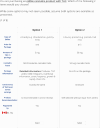Exploring consumer preferences for cannabis edible products to support public health policy: A discrete choice experiment
- PMID: 38753807
- PMCID: PMC11098505
- DOI: 10.1371/journal.pone.0292336
Exploring consumer preferences for cannabis edible products to support public health policy: A discrete choice experiment
Abstract
Background: In October 2019, cannabis edibles were legalized for sale in Canada for non-medical use. This move was intended to improve public safety by regulating contents (including a maximum 10 mg tetrahydrocannabinol (THC) per package) and packaging to prevent accidental ingestion or over consumption. This study aimed to explore consumer preferences for cannabis edibles to inform cannabis policy.
Methods: We explored the relative importance and trade-offs consumers make for attributes of cannabis edibles using a discrete choice experiment. Attributes included type of edible, price, THC content, cannabis taste, package information, product consistency, product recommendations, and Health Canada regulation. Participants lived in Canada, were 19 years of age or older, and purchased a cannabis edible in the last 12 months. A multinomial logit (MNL) model was used for the base model, and latent class analysis to assess preference sub-groups. This study was approved by the institutional ethics committee.
Results: Among 684 participants, the MNL model showed that potency was the most relevant attribute, followed by edible type. A two-group latent class model revealed two very distinct preference patterns. Preferences for group 1 (~65% of sample) were driven primarily by edible type, while for group 2 (~35% of sample) were driven almost entirely by THC potency.
Conclusion: This study found that consumer preferences for ~65% of consumers of cannabis edibles are being met through regulated channels. The remaining ~35% are driven by THC potency at levels that are not currently available on the licensed market. Attracting this market segment will require reviewing the risks and benefits of restricting THC package content.
Copyright: © 2024 Donnan et al. This is an open access article distributed under the terms of the Creative Commons Attribution License, which permits unrestricted use, distribution, and reproduction in any medium, provided the original author and source are credited.
Conflict of interest statement
The authors have declared that no competing interests exist.
Figures
Similar articles
-
Exploring Consumer Preferences for Cannabis Vaping Products to Support Public Health Policy: A Discrete Choice Experiment.Appl Health Econ Health Policy. 2023 Jul;21(4):651-659. doi: 10.1007/s40258-023-00804-w. Epub 2023 Apr 15. Appl Health Econ Health Policy. 2023. PMID: 37060511 Free PMC article.
-
The impacts of packaging on preferences for cannabis edibles: A discrete choice experiment.Int J Drug Policy. 2024 Jun;128:104453. doi: 10.1016/j.drugpo.2024.104453. Epub 2024 May 25. Int J Drug Policy. 2024. PMID: 38796927
-
Drivers of Purchase Decisions Among Consumers of Dried Flower Cannabis Products: A Discrete Choice Experiment.J Stud Alcohol Drugs. 2023 Sep;84(5):744-753. doi: 10.15288/jsad.22-00269. Epub 2023 May 18. J Stud Alcohol Drugs. 2023. PMID: 37219026
-
Cannabis sativa Cannabinoids as Functional Ingredients in Snack Foods-Historical and Developmental Aspects.Plants (Basel). 2022 Dec 1;11(23):3330. doi: 10.3390/plants11233330. Plants (Basel). 2022. PMID: 36501366 Free PMC article. Review.
-
Characteristics that influence purchase choice for cannabis products: a systematic review.J Cannabis Res. 2022 Feb 1;4(1):9. doi: 10.1186/s42238-022-00117-0. J Cannabis Res. 2022. PMID: 35105374 Free PMC article. Review.
Cited by
-
Patterns of Cannabis Use among Women With HIV in the United States.AIDS Behav. 2025 Jun;29(6):2022-2032. doi: 10.1007/s10461-025-04669-z. Epub 2025 Mar 7. AIDS Behav. 2025. PMID: 40050488
-
Exploring pain management preferences: a discrete choice experiment on cannabis or opioids among middle-aged and older adults.J Health Popul Nutr. 2025 Jul 3;44(1):225. doi: 10.1186/s41043-025-00989-x. J Health Popul Nutr. 2025. PMID: 40611345 Free PMC article.
-
Novel potential of low calorie plant burger: Functional turkey meat formulation optimized by replacing quinoa, chia, soy, amaranth and peas as vegetable protein and their influence on texture and sensory traits.PLoS One. 2025 Jul 23;20(7):e0325622. doi: 10.1371/journal.pone.0325622. eCollection 2025. PLoS One. 2025. PMID: 40700423 Free PMC article.
References
-
- Branch LS. Consolidated federal laws of Canada, Cannabis Act [Internet]. Oct 17, 2020. Available from: https://laws-lois.justice.gc.ca/eng/acts/c-24.5/
-
- Canada H. About cannabis [Internet]. 2018 [cited 2023 Dec 5]. Available from: https://www.canada.ca/en/health-canada/services/drugs-medication/cannabi...
-
- Ransing R, de la Rosa PA, Pereira-Sanchez V, Handuleh JIM, Jerotic S, Gupta AK, et al.. Current state of cannabis use, policies, and research across sixteen countries: cross-country comparisons and international perspectives. Trends Psychiatry Psychother. 2022. Jun 27;44(Suppl 1):e20210263. doi: 10.47626/2237-6089-2021-0263 - DOI - PMC - PubMed
-
- Canada H. Canadian cannabis survey 2017—Summary [Internet]. 2017 [cited 2021 Sep 2]. Available from: https://www.canada.ca/en/health-canada/services/publications/drugs-healt...
-
- Canadian Cannabis Survey 2019—Summary [Internet]. Service Canada; 2019 [cited 2020 Aug 24]. Available from: https://www.canada.ca/en/health-canada/services/publications/drugs-healt...
MeSH terms
LinkOut - more resources
Full Text Sources
Miscellaneous



